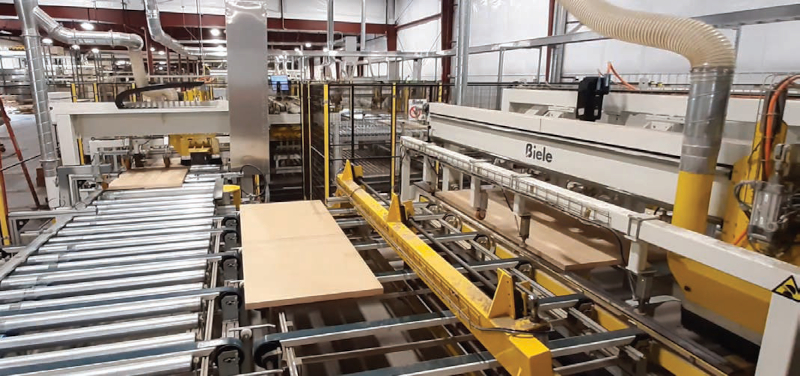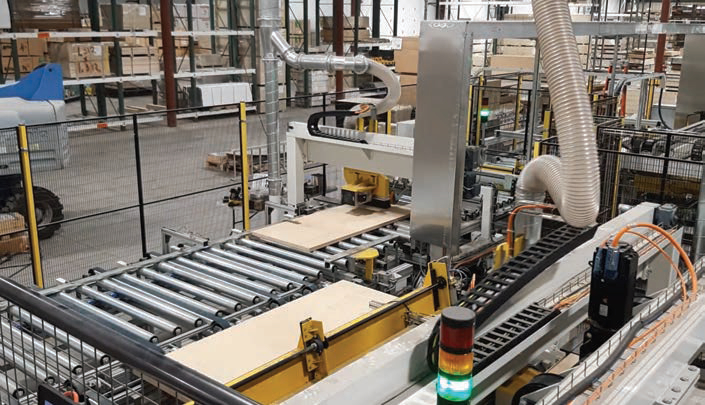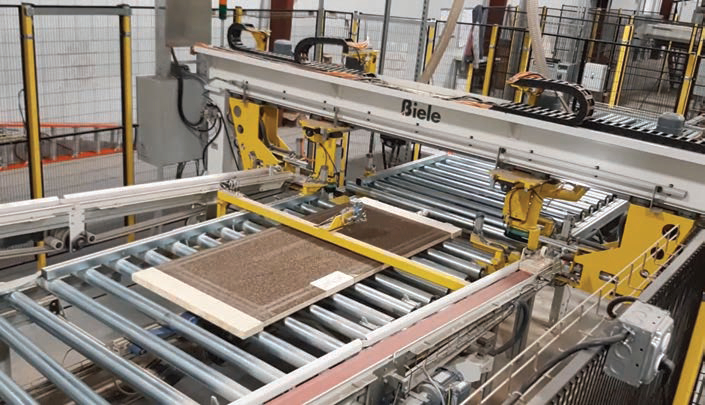Opening doors
19 September 2022North American door manufacturing giant VT Industries has partnered with Biele in extensive growth and expansion projects over the last few years
VT Industries has been on a solid growth and expansion curve over recent years.
Headquartered in Holstein, Iowa, the company is a leading North American manufacturer of architectural wood doors, postformed laminate countertops and architectural stone surfaces.
It currently operates 11 manufacturing facilities across the US and Canada, employing more than 630 people.
In 2016, VT celebrated its 60th anniversary at a time of great expansion and upgrading for its manufacturing facilities.
It had already embarked on the expansion of the Holstein architectural wood door manufacturing facility in 2014 with Biele, leading to several different projects between the two in the following eight years.
The initial 2014 project was the result of VT’s business growth strategy requiring an investment in a second door core assembly machine line (CAM) in Holstein to allow production capacity to be increased and so additional capabilities could be integrated.
After this initial project, Biele continued working on additional factory capacity, installing further handling solutions for new CNC lines in 2016.
But the most recent project between VT and Biele took place in 2021 at the Neenah facility – which came with the acquisition in 2018 of Eggers Industries, a national manufacturer of architectural plywood doors for the top tier of the custom door market, based in Wisconsin.
EXPANSION AT NEENAH FACILITY
The facility in Neenah produces door slabs that are pre-finished, pre-machined and glazed, with any combination required.
VT’s growth plan for the Neenah site focused on replacing existing older core processing equipment with a new automatic CAM line. The experience of Biele’s installation at Holstein aided the selection of Biele for the project.
The project was divided into two parts – the Core Optimiser, where different panels are cut and glued together until the desired core size is completed, and the Frame Assembly where rails, stiles and lock blocks are added.
The Composer is the part where the infeed panels need to be optimised in a way that, regardless of the size of the infeed panel, the final composed core can be delivered in a batch size 1 basis. This may result in final cores composed by multiple different infeed panels, with a minimum waste of raw material.
In the Composer, the infeed panel is trimmed and profiled, and glued with EVA hot melt glue in the short side of the panel first, which is glued together with the next one, producing a continuous length panel that is cut to length according to the size of the core to be produced.
The operation is repeated with the long side of the panel, in a way that the final width of the core is produced.
This panel optimising logic could not be understood without the production control system developed by Biele’s digital division.
This software, called Production Control, brings intelligence to the whole production line, specially focused in the panel optimiser area. This logic is not just a static calculation of the infeed panel sizes to glue and cut them until the desired size is achieved. It goes beyond that, since the optimiser is able to use a cutting logic that measures the deviations of the first cut and compensates it with the second cut in the next board to stay within the established tolerance range, so that the reject material is reduced significantly.
The second part of the line corresponds to the frame assembly section, where the stiles and rails are glued and placed around the previously composed core.
Firstly, the front and back rails are glued and placed around the core, and after they are cut to size, the same operation is done with the two stiles. Finally, the excess of length of the stiles is cut resulting in the final dimension of the core.
Biele also equipped the lines to have the capacity to introduce lock blocks into the core. Furthermore, the Eggers line also provides the possibility to make an additional slot on the sides so that cables can be inserted for electronic opening doors. To finish, the door is sanded from both top and bottom faces.
BENEFITS OF THE NEW LINES
By means of these two lines, VT Industries says it has managed to consistently increase the production volumes as planned.
In Holstein, the CAM line was targeted at higher capacity rates and additional functionality.
“VT was able to achieve capacity targets, streamlining product and process redundancy,” said Keith Horan, engineering manager at VT Industries.
VT’s goal had been to achieve a production capacity of 15,000 parts/week – a target the new installation has met.
“The integration of additional CNC equipment into the line helped us to keep product orders together, eliminating manual processing and sortation,” added Mr Horan.
“Biele did a great job with the automation of the line, since there was a complex job to be done by integrating three external vendors’ equipment, one third party software and VT’s ERP data.”
David Streu, automation and engineering manager in Eggers division, said the new line’s additional capacity at Eggers allowed a reduction from three shifts down to two shifts.
This, VT says, together with the reduction of operator needs, resulted in considerable cost savings for the company.
Furthermore, at Holstein and Neenah, a change in how the core and parts were justified and trimmed in the assembly section was made. Therefore, the final core squareness and part alignment was improved.
In Neenah, Biele’s provision of additional capabilities, such as the self-developed customised optimiser software and a lock block routing and insertion machine, allows the cores to be cut and lock blocks to be installed with only five seconds of additional cycle time to the line. “The optimiser allowed us to reduce core SKU’s from over 50 unique core parts to under 10,” said Mr Streu.
“This allowed us to reduce overall inventory of core, freeing up valuable space in our warehouse. The addition of the core optimiser allowed Neenah to optimise its own fire core, saving the business several hundred thousand dollars per year.”
From Biele’s side, the eight-year collaboration with VT Industries has provided a challenge and valuable experience to enrich the door manufacturing knowledge it has been acquiring since its foundation.
“The continuity of the relationship with VT, including various projects in the last eight years, makes us feel proud of our work and is a clear sign of a well-done job,” said a Biele spokesperson.
Biele said the collaborative working philosophy present between the two companies was important.
“From the beginning there was a perfect understanding between the engineering teams of both companies, combining Biele’s knowledge of automation and panel optimisation, and VT’s expertise in door manufacturing.”
“Biele was a new vendor for VT and its approach was impressive,” said VT’s Keith Horan.
“It was presented with a short time frame for development and concept proposal through the holiday season,” he said. “They helped us to develop clear requirements for the process needs and openly discussed solution concepts and business opportunities.”
David Streu added that Biele’s willingness to communicate and learn VT’s processes was key to the success of this project.


